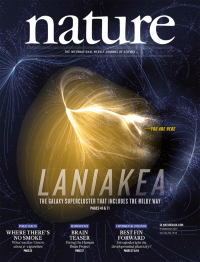Volume 513
-
No. 7519 25 September 2014
According to the theory of island biogeography, the number of species (richness) is determined by how an island's area and isolation govern rates of colonization, extinction and speciation. There is a long history of human introduction of anole lizards to Caribbean islands, hitching a ride on on crops such as pineapple and recently on ornamental plants for hotel gardens. Matt Helmus et al. take advantage of this spread of exotic species to conduct a large-scale direct test of the theory of island biogeography. Their results confirm some theoretical predictions geographic area remains a good positive predictor of species richness, for instance. But in a world dominated by humans, geographic isolation as a negative predictor of richness has been replaced by economic isolation. For example, shipping traffic among islands is unrelated to geographic isolation and is instead linked to trade policy illustrated by the fact that the US embargo has reduced the number of exotic anoles established on Cuba. Cover: Cuban green anole (Anolis porcatus) established in the Dominican Republic (photo: Miguel Landestoy T)
-
No. 7518 18 September 2014
By sequencing and comparing the genomes of nine ancient Europeans that bridge the transition to agriculture in Europe between 8,000 and 7,000 years ago, David Reich and colleagues show that most present-day Europeans derive from at least three highly differentiated populations west European hunter-gatherers, ancient north Eurasians (related to Upper Palaeolithic Siberians) and early European farmers of mainly Near Eastern origin. They further propose that early European farmers had about 44% ancestry from a basal Eurasian population that split before the diversification of other non-African lineages. These results raise interesting new questions, for instance that of where and when the Near Eastern farmers mixed with European hunter-gatherers to produce the early European farmers. Cover: Leonardo Gonzalez.
Insight
-
No. 7517 11 September 2014
Pepper, a 5-month-old female northern white-cheeked gibbon (Nomascus leucogenys). The many species of gibbons are small, tree-living apes from Southeast Asia, most of them listed as endangered or critically endangered on the IUCN list. In their presentation of the Nomascus leucogenys genome, Lucia Carbone and colleagues provide intriguing insights into the biology and evolutionary history of a group that straddles the divide between Old World monkeys and the great apes. The authors investigate how a novel gibbon-specific retrotransposon might be the source of gibbons genome plasticity. Rapid karyotype evolution combined with multiple episodes of climate and environmental change might explain the almost instantaneous divergence of the four gibbon genera. Positive selection on genes involved in forelimb development and connective tissue might have been related to gibbons unique mode of locomotion in the tropical canopy. Cover: Gabriella Skollar, July 2011 at The Gibbon Conservation Center in Santa Clarita, CA.
Nature Outlook
-
No. 7516 4 September 2014
A slice through the Laniakea supercluster home: velocity flow streams within our supercluster are shown white, external flows dark blue. The Milky Way is a member of the Local Group of galaxies. The Milky Way is a member of the Local Group of galaxies. Now have sufficient data on the distances and motions of galaxies to be able to describe a much larger level of organization in our corner of the Universe a supercluster 160 megaparsecs across and containing 1017 solar masses. Brent Tully et al. use a new catalogue of peculiar velocities, line-of-sight departures from cosmic expansion caused by gravitational perturbation, to develop a map representing the distribution of matter. They identify a home supercluster that they name Laniakea from the Hawaiian lani and akea (heaven and spacious). It includes the Virgo cluster, the Norma, Hydra and Centaurus clusters (also known as the Great Attractor), the Pavo-Indus filament and a number of voids. Cover art: Mark A. Garlick / source, Daniel Pomarede.




